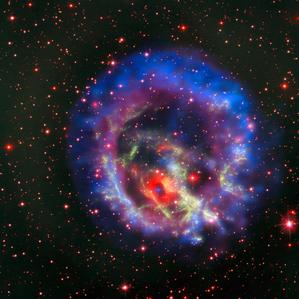Glossary term: Étoile à neutrons
Description: Une étoile à neutrons est un vestige stellaire très dense et compact résultant de l'effondrement du cœur d'une étoile massive. Les étoiles d'une masse égale ou supérieure à huit masses solaires terminent leur évolution stellaire par l'effondrement de leur cœur, ce qui déclenche l'explosion d'une supernova. Le noyau effondré a une densité supérieure à celle de la plupart des noyaux atomiques et se compose principalement de neutrons. Ce dernier point est dû au fait que les protons et les électrons se combinent pour former des neutrons dans le cœur effondré extrêmement chaud et dense de l'étoile massive. La limite inférieure de la masse d'une étoile à neutrons est de 1,4 masse solaire, et la limite supérieure d'environ 3 masses solaires. Les étoiles à neutrons fortement magnétiques sont appelées magnétars. La grande majorité des étoiles à neutrons connues sont observées sous forme de pulsars radio.
Related Terms:
See this term in other languages
Term and definition status: The original definition of this term in English have been approved by a research astronomer and a teacher The translation of this term and its definition is still awaiting approval
The OAE Multilingual Glossary is a project of the IAU Office of Astronomy for Education (OAE) in collaboration with the IAU Office of Astronomy Outreach (OAO). The terms and definitions were chosen, written and reviewed by a collective effort from the OAE, the OAE Centers and Nodes, the OAE National Astronomy Education Coordinators (NAECs) and other volunteers. You can find a full list of credits here. All glossary terms and their definitions are released under a Creative Commons CC BY-4.0 license and should be credited to "IAU OAE".
Related Media
Death of a massive star
Credit: ESO/NASA, ESA and the Hubble Heritage Team (STScI/AURA)/F. Vogt et al. credit link
License: CC-BY-4.0 Creative Commons Attribution 4.0 International (CC BY 4.0) icons









